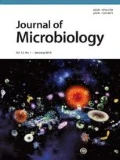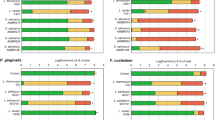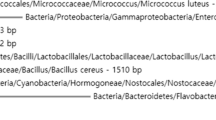Abstract
The interaction between Lactobacillus reuteri, a probiotic bacterium, and oral pathogenic bacteria have not been studied adequately. This study examined the effects of L. reuteri on the proliferation of periodontopathic bacteria including Aggregatibacter actinomycetemcomitans, Fusobacterium nucleatum, Porphyromonas gingivalis, and Tannerella forsythia, and on the formation of Streptococcus mutans biofilms. Human-derived L. reuteri strains (KCTC 3594 and KCTC 3678) and rat-derived L. reuteri KCTC 3679 were used. All strains exhibited significant inhibitory effects on the growth of periodontopathic bacteria and the formation of S. mutans biofilms. These antibacterial activities of L. reuteri were attributed to the production of organic acids, hydrogen peroxide, and a bacteriocin-like compound. Reuterin, an antimicrobial factor, was produced only by L. reuteri KCTC 3594. In addition, L. reuteri inhibited the production of methyl mercaptan by F. nucleatum and P. gingivalis. Overall, these results suggest that L. reuteri may be useful as a probiotic agent for improving oral health.
Similar content being viewed by others
References
Aas, J.A., B.J. Paster, L.N. Stokes, I. Olsen, and F.E. Dewhirst. 2005. Defining the normal bacterial flora of the oral cavity. J. Clin. Microbiol. 43, 5721–5732.
Abad, C.L. and N. Safdar. 2009. The role of Lactobacillus probiotics in the treatment or prevention of urogenital infections-a systematic review. J. Chemother. 21, 243–252.
Ahola, A.J., H. Yli-Knuuttila, T. Suomalainen, T. Poussa, A. Ahlström, J.H. Meurman, and R. Korpela. 2002. Short-term consumption of probiotic-containing cheese and its effect on dental caries risk factors. Arch. Oral Biol. 47, 799–804.
Burton, J.P., C.N. Chilcott, and J.R. Tagg. 2005. The rationale and potential for the reduction of oral malodour using Streptococcus salivarius probiotics. Oral Dis. 11, 29–31.
Çaglar, E., S.K. Cildir, S. Ergeneli, N. Sandalli, and S. Twetman. 2006. Salivary mutans streptococci and lactobacilli levels after ingestion of the probiotic bacterium Lactobacillus reuteri ATCC 55730 by straws or tablets. Acta Odontol. Scand. 64, 314–318.
Cleusix, V., C. Lacroix, S. Vollenweider, M. Duboux, and G. Le Blay. 2007. Inhibitory activity spectrum of reuterin produced by Lactobacillus reuteri against intestinal bacteria. BMC Microbiol. 7, 101.
Coli, J.M. and J. Tonzetich. 1992. Characterization of volatile sulphur compounds production at individual gingival crevicular sites in humans. J. Clin. Dent. 3, 97–103.
De Boever, E.H. and W.J. Loesche. 1995. Assessing the contribution of anaerobic microflora of the tongue to oral malodor. J. Am. Dent. Assoc. 126, 1384–1393.
Doleyres, Y., P. Beck, S. Vollenweider, and C. Lacroix. 2005. Production of 3-hydroxypropionaldehyde using a two-step process with Lactobacillus reuteri. Appl. Microbiol. Biotechnol. 68, 467–474.
El-Ziney, M.G., T. van den Tempel, J. Debevere, and M. Jakobsen. 1999. Application of reuterin produced by Lactobacillus reuteri 12002 for meat decontamination and preservation. J. Food Prot. 62, 257–261.
Eschenbach, D.A., P.R. Davick, B.L. Williams, S.J. Klebanoff, K. Young-Smith, C.M. Critchlow, and K.K. Holmes. 1989. Prevalence of hydrogen peroxide-producing Lactobacillus species in normal women and women with bacterial vaginosis. J. Clin. Microbiol. 27, 251–256.
Gill, H.S., Q. Shu, H. Lin, K.J. Rutherfurd, and M.L. Cross. 2001. Protection against translocating Salmonella typhimurium infection in mice by feeding the immuno-enhancing probiotic Lactobacillus rhamnosus strain HN001. Med. Microbiol. Immunol. 190, 97–104.
Gilliland, S.E., C.R. Nelson, and C. Maxwell. 1985. Assimilation of cholesterol by Lactobacillus acidophilus. Appl. Environ. Microbiol. 49, 377–381.
Haffajee, A.D. and S.S. Socransky. 1994. Microbial etiological agents of destructive periodontal diseases. Periodontol. 2000 5, 78–111.
Haffajee, A.D., R.P. Teles, and S.S. Socransky. 2006. Association of Eubacterium nodatum and Treponema denticola with human periodontitis lesions. Oral Microbiol. Immunol. 21, 269–282.
Ishihara, K., H. Miyakawa, A. Hasegawa, I. Takazoe, and Y. Kawai. 1985. Growth inhibition of Streptococcus mutans by cellular extracts of human intestinal lactic acid bacteria. Infect. Immun. 49, 692–694.
Kang, M.S., E.K. Choi, D.H. Choi, S.Y. Ryu, H.H. Lee, H.C. Kang, J.T. Koh, and et al. 2008. Antibacterial activity of pyrrolidine dithiocarbamate. FEMS Microbiol. Lett. 280, 250–254.
Kang, M.S., J. Chung, S.M. Kim, K.H. Yang, and J.S. Oh. 2006a. Effect of Weissella cibaria isolates on the formation of Streptococcus mutans biofilm. Caries Res. 40, 418–425.
Kang, M.S., B.G. Kim, J. Chung, H.C. Lee, and J.S. Oh. 2006b. Inhibitory effect of Weissella cibaria isolates on the production of volatile sulphur compounds. J. Clin. Periodontol. 33, 226–232.
Kasuga, Y., K. Ishihara, and K. Okuda. 2000. Significance of detection of Porphyromonas gingivalis, Bacteroides forsythus and Treponema denticola in periodontal pockets. Bull. Tokyo Dent. Coll. 41, 109–117.
Kawamura, Y., X.G. Hou, F. Sultana, H. Miura, and T. Ezaki. 1995. Determination of 16S rRNA sequences of Streptococcus mitis and Streptococcus gordonii and phylogenetic relationships among members of the genus Streptococcus. Int. J. Syst. Bacteriol. 45, 406–408.
Kleinberg, I. and G. Westbay. 1992. Salivary and metabolic factors involved in oral malodor formation. J. Periodontol. 63, 768–775.
Köll-Klais, P., R. Mändar, E. Leibur, H. Marcotte, L. Hammarström, and M. Mikelsaar. 2005. Oral lactobacilli in chronic periodontitis and periodontal health: species composition and antimicrobial activity. Oral Microbiol. Immunol. 20, 354–361.
Lancero, H., J. Niu, and P.W. Johnson. 1996. Exposure of periodontal ligament cells to methyl mercaptan reduces intracellular pH and inhibits cell migration. J. Dent. Res. 75, 1994–2002.
Loesche, W.J. 1986. Role of Streptococcus mutans in human dental decay. Microbiol. Rev. 50, 353–380.
Lüthi-Peng, Q., S. Schärer, and Z. Puhan. 2002. Production and stability of 3-hydroxypropionaldehyde in Lactobacillus reuteri. Appl. Microbiol. Biotechnol. 60, 73–80.
Mandell, R.L. 1984. A longitudinal microbiological investigation of Actinobacillus actinomycetemcomitans and Eikenella corrodens in juvenile periodontitis. Infect. Immun. 45, 778–780.
Meyer, D.H. and P.M. Fives-Taylor. 1997. The role of Actinobacillus actinomycetemcomitans in the pathogenesis of periodontal disease. Trends Microbiol. 5, 224–228.
Nikawa, H., S. Makihira, H. Fukushima, H. Nishimura, Y. Ozaki, and K. Ishida. 2004. Lactobacillus reuteri in bovine milk fermented decreases the oral carriage of mutans streptococci. Int. J. Food Microbiol. 95, 219–223.
Paster, B.J., S.K. Boches, J.L. Galvin, R.E. Ericson, C.N. Lau, V.A. Levanos, A. Sahasrabudhe, and F.E. Dewhirst. 2001. Bacterial diversity in human subgingival plaque. J. Bacteriol. 183, 3770–3783.
Paster, B.J., I. Olsen, J.A. Aas, and F.E. Dewhirst. 2006. The breadth of bacterial diversity in the human periodontal pocket and other oral sites. Periodontol. 2000 42, 80–87.
Persson, S., M.B. Edlund, R. Claesson, and J. Carlsson. 1990. The formation of hydrogen sulfide and methyl mercaptan by oral bacteria. Oral Microbiol. Immunol. 5, 195–201.
Reid, G., J. Burton, and E. Devillard. 2004. The rationale for probiotics in female urogenital healthcare. MedGenMed. 6, 49.
Saavedra, J. 2000. Probiotics and infectious diarrhea. Am. J. Gastroenterol. 95, 16–18.
Scully, C., M. el-Maaytah, S.R. Porter, and J. Greenman. 1997. Breath odor: etiopathogenesis, assessment and management. Eur. J. Oral Sci. 105, 287–293.
Shornikova, A.V., I.A. Casas, H. Mykkänen, E. Salo, and T. Vesikari. 1997. Bacteriotherapy with Lactobacillus reuteri in rotavirus gastroenteritis. Pediatr. Infect. Dis. J. 16, 1103–1107.
Slininger, P.J., R.J. Bothast, and K.L. Smiley. 1983. Production of 3-hydroxypropionaldehyde from glycerol. Appl. Environ. Microbiol. 46, 62–67.
Slots, J. and M. Ting. 1999. Actinobacillus actinomycetemcomitans and Porphyromonas gingivalis in human periodontal disease: occurrence and treatment. Periodontol. 2000 20, 82–121.
Socransky. S.S., A.D. Haffajee, M.A. Cugini, C. Smith, and R.L. Kent, Jr. 1998. Microbial complexes in subgingival plaque. J. Clin. Periodontol. 25, 134–144.
Spinler, J.K., M. Taweechotipatr, C.L. Rognerud, C.N. Ou, S. Tumwasorn, and J. Versalovic. 2008. Human-derived probiotic Lactobacillus reuteri demonstrate antimicrobial activities targeting diverse enteric bacterial pathogens. Anaerobe 14, 166–171.
Szajewska, H. and J.Z. Mrukowicz. 2005. Use of probiotics in children with acute diarrhea. Paediatr. Drugs 7, 111–122.
Talarico, T.L., I.A. Casas, T.C. Chung, and W.J. Dobrogosz. 1988. Production and isolation of reuterin, a growth inhibitor produced by Lactobacillus reuteri. Antimicrob. Agents Chemother. 32, 1854–1858.
Taniguchi, M., H. Nakazawa, O. Takeda, T. Kaneko, K. Hoshino, and T. Tanaka. 1998. Production of a mixture of antimicrobial organic acids from lactose by co-culture of Bifidobacterium longum and Propionibacterium freudenreichii. Biosci. Biotechnol. Biochem. 62, 1522–1527.
Tonzetich, J. 1971. Direct gas chromatographic analysis of sulphur compounds in mouth air in man. Arch. Oral Biol. 16, 587–597.
van Winkelhoff, A.J., B.G. Loos, W.A. van der Reijden, and U. van der Velden. 2002. Porphyromonas gingivalis, Bacteroides forsythus and other putative periodontal pathogens in subjects with and without periodontal destruction. J. Clin. Periodontol. 29, 1023–1028.
Author information
Authors and Affiliations
Corresponding author
Rights and permissions
About this article
Cite this article
Kang, MS., Oh, JS., Lee, HC. et al. Inhibitory effect of Lactobacillus reuteri on periodontopathic and cariogenic bacteria. J Microbiol. 49, 193–199 (2011). https://doi.org/10.1007/s12275-011-0252-9
Received:
Accepted:
Published:
Issue Date:
DOI: https://doi.org/10.1007/s12275-011-0252-9




